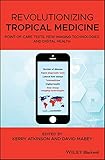Revolutionizing tropical medicine : point-of-care tests, new imaging technologies and digital health / edited by Kerry Atkinson, David Mabey.
Material type: TextPublisher: Hoboken, NJ : Wiley Blackwell, 2019Description: 1 online resource (xxxix, 728 pages)Content type:
TextPublisher: Hoboken, NJ : Wiley Blackwell, 2019Description: 1 online resource (xxxix, 728 pages)Content type: - text
- computer
- online resource
- 9781119282655
- 1119282659
- 9781119282686
- 1119282683
- 9781119282679
- 1119282675
- Tropical medicine -- Technological innovations
- Point-of-care testing -- Developing countries
- Medical care -- Developing countries
- Tropical Medicine
- Point-of-Care Testing
- Telemedicine
- Developing Countries
- HEALTH & FITNESS -- Diseases -- General
- MEDICAL -- Clinical Medicine
- MEDICAL -- Diseases
- MEDICAL -- Evidence-Based Medicine
- MEDICAL -- Internal Medicine
- Medical care
- Point-of-care testing
- Developing countries
- 616.9/883 23
- RC961 .R48 2019
- WC 680
Includes bibliographical references and index.
"Revolutionizing Tropical Medicine offers an up-to-date guide for healthcare and other professionals working in low-resource countries where access to health care facilities for diagnosis and treatment is challenging. Rather than suggesting the expensive solution of building new bricks and mortar clinics and hospitals and increasing the number of doctors and nurses in these deprived areas, the authors propose a complete change of mindset. They outline a number of ideas for improving healthcare including rapid diagnostic testing for infectious and non-infectious diseases at a point-of-care facility, together with low cost portable imaging devices. In addition, the authors recommend a change in the way in which health care is delivered"--Provided by publisher.
Online resource; title from digital title page (viewed on September 12, 2019).
<P><b>Section 1. The health of low- to middle-income countries today </b></p> <p>1. The burden of communicable diseases in low- to middle-income countries today<br /><i>Kerry Atkinson and David Mabey</i></p> <p>2. The burden of non-communicable diseases in low- to middle-income countries today<br /><i>Heiner Grosskurth</i></p> <p><b>Section 2. How to improve health care in low- to middle-income countries by primary point-of-care rapid diagnostic testing</b></p> <p>3. The optimal features of a rapid point-of-care diagnostic test<br /><i>David Mabey and Rosanna Peeling</i></p> <p>4. Revolutionizing HIV healthcare delivery through rapid and point-of-care testing<br /><i>Catherine J. Wedderburn, Debrah I. Boeras and Rosanna W. Peeling</i></p> <p>5. Rapid point-of-care diagnostic tests for tuberculosis<br /><i>Richard Lessells</i></p> <p>6. Rapid diagnostic tests for syphilis<br /><i>David Mabey, Michael Marks and Rosanna Peeling</i></p> <p>7. Point-of-care and near-point-of-care diagnostic tests for malaria: light microscopy, rapid antigen-detecting tests and nucleic acid amplification assays<br /><i>Heidi Hopkins and Jane Cunningham</i></p> <p>8. Rapid diagnostic tests for human African trypanosomiasis<br /><i>Veerle Legon, Epco Hasker and Philippe Büscher</i></p> <p>9. Rapid diagnostic tests for visceral leishmaniasis<br /><i>Marleen Boelaert, Suman Rijal and François Chappuis</i></p> <p>10.A rapid diagnostic test for dengue<br /><i>Claire Mullender and James Whitehorn</i></p> <p>11. Rapid diagnostic tests for influenza<br /><i>A.C. Hurt and I.G. Barr</i></p> <p>12. A rapid diagnostic test for Ebola virus disease<br /><i>Catherine Houlihan and Colin Brown</i></p> <p>13. Rapid diagnostic tests for yaws<br /><i>Michael Marks</i></p> <p>14. Rapid diagnostic tests for the detection of sickling hemoglobin<br /><i>Amina Nardo-Marino and Thomas N. Williams</i></p> <p>15. Progress toward the development of rapid diagnostic tests for lymphatic filariasis and onchocerciasis<br /><i>Roger B. Peck, Dunia Faulx and Tala de los Santos</i></p> <p><b>Section 3. Other tests that can be performed rapidly at the primary-point-of care </b></p> <p>16. Point-of-care testing for blood counts, HbA1c, renal function,electrolytes, acid-base balance and hepatitis<br /><i>Mark Shephard, Lara Motta, Brooke Spaeth, Heather Halls and Lauren Duckworth</i></p> <p>17. Microscopy skills: cell counts, Gram stains and blood films<br /><i>Michael Harrison</i></p> <p>18. India ink stain and cryptococcal antigen test for cryptococcal infection<br /><i>Hannah K. Mitchell, Joseph N. Jarvis and Mark W. Tenforde</i></p> <p>19. Mid upper arm circumference tapes for assessment of severe acute malnutrition<br /><i>Jane Crawley, Martha Mwangome, James Berkley and André Briend</i></p> <p>20. Spirometry for chronic obstructive pulmonary disease due to inhalation of smoke from indoor fires used for cooking and heating<br /><i>Janet G. Shaw1, Annalicia Vaughan1, Emma Smith, Cai Fong, Svetlana Stevanovic and Ian A.Yang</i></p> <p>21. Point-of-care pulse oximetry for children in low-resource Settings<br /><i>Carina King, Hamish Graham and Eric D. McCollum</i></p> <p>22. The use of near-infrared spectroscopy to monitor tissue oxygenation, metabolism and injury in low resource settings<br /><i>Gemma Bale and Ilias Tachtsidis</i></p> <p><b>Section 4. Cheap imaging technologies</b></p> <p>23. The use of point-of-care ultrasound in the resource-limited setting<br /><i>Tom Heller, Michaëla AM Huson, Sabine Bélard, Dan Kaminstein and Elizabeth Joekes</i></p> <p>24. The use of obstetric ultrasound in low resource settings<br /><i>Helen Allott</i></p> <p>25. Examining the optic fundus and assessing visual acuity and visual fields using mobile technology<br /><i>Nigel M Bolster and Andrew Bastawrous</i></p> <p><b>Section 5. Telemedicine</b></p> <p>26. Telemedicine for clinical management of adults in remote and rural areas<br /><i>Farhad Fatehi, Monica Taylor, Liam J. Caffery and Anthony C. Smith</i></p> <p>27. Telemedicine for the delivery of specialist pediatric services<br /><i>Anthony C Smith, Monica Taylor, Farhad Fetehi and Liam J Caffery</i></p> <p>28. Telemedicine in the diagnosis and management of skin diseases<br /><i>Giselle Prado, Odinaka Anyanwu and Carrie Kovarik</i></p> <p>29. Digital technology, including telemedicine, in the management of mental illness<br /><i>John A Naslund, Sophia M. Bartels and Lisa A.Marsch</i></p> <p>30. The use of mobile chest x-rays for tuberculosis telemedicine<br /><i>Meghan L. Jardon, Kelsey L. Pomykala, Ishita Desai, Kara-Lee Pool</i></p> <p><b>Section 6. The future</b></p> <p>31. An introduction to digital health<br /><i>Kerry Atkinson</i></p> <p>32. Digital health in low and middle income countries<br /><i>Martin Seneviratne</i></p> <p>33. Nucleic acid detection of tuberculosis via innovative point-of- care nanotechnologies targeted for low resource settings<br /><i>Benjamin Y.C.Eugene J.H. Wee, Nicholas P. West and Matt Trau1</i></p> <p>34. The use of functional nanoparticles for water purification<br /><i>Jing Zhang, Chuanping Feng, and Chengzhong Yu</i></p> <p>35. The use of drones in the delivery of rural healthcare<br /><i>Debrah I. Boeras, Blanche C. Collins and Rosanna W. Peeling</i></p> <p>36. Implementation of point-of-care tests: lessons learnt<br /><i>Rosanna W. Peeling and Debrah I. Boeras</i></p> <p>37. Useful electronic health care resources available for those working in remote settings<br /><i>Tyler Evans</i></p> <p>38. The future -- how do we get from here to there?<br /><i>Kerry Atkinson and David Mabey</i></p> <p> </p>
There are no comments on this title.
